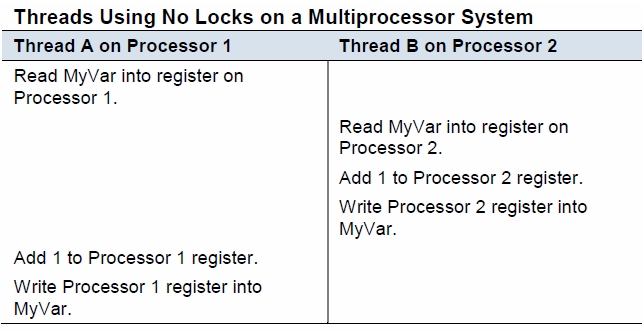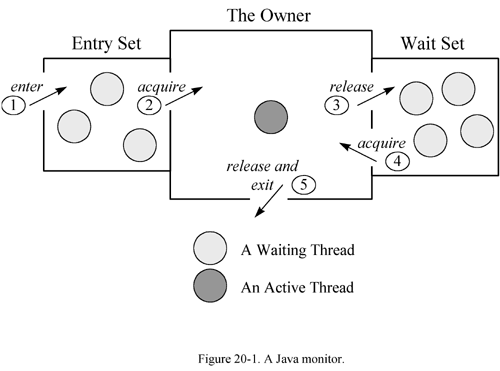CSC/ECE 506 Spring 2012/9a mm: Difference between revisions
No edit summary |
No edit summary |
||
| Line 25: | Line 25: | ||
====Monitors in Java==== | ====Monitors in Java==== | ||
Monitors in Java are conceptual spaces that can be occupied by only one thread at a time. Entering the monitor space is termed ''entering the monitor''. The monitor space has a conceptual inner region which when entering is called ''acquiring the monitor''. Occupying this inner region is called ''owning the monitor'' while leaving it is called ''releasing the monitor'' and exiting the monitor space all together is called ''exiting the monitor''. No more than one thread can own the monitor at any given time. This region of the monitor typically contains data and code that potentially support two types of synchronization available with Java, mutual exclusion and cooperation. Monitors can contain many code regions, related or not, which each when executed must do so with a [[File:Java_monitor.gif| | Monitors in Java are conceptual spaces that can be occupied by only one thread at a time. Entering the monitor space is termed ''entering the monitor''. The monitor space has a conceptual inner region which when entering is called ''acquiring the monitor''. Occupying this inner region is called ''owning the monitor'' while leaving it is called ''releasing the monitor'' and exiting the monitor space all together is called ''exiting the monitor''. No more than one thread can own the monitor at any given time. This region of the monitor typically contains data and code that potentially support two types of synchronization available with Java, mutual exclusion and cooperation. Monitors can contain many code regions, related or not, which each when executed must do so with a [[File:Java_monitor.gif|600px|thumb|rignt|Java Monitor]]guarantee of atomicity with respect to other executing threads. Each code region has its own ''entry set''. This means that each monitor has multiple points of entry, each of which is associated with a particular region of code that for correctness must be synchronized. When a thread, in its course of execution, comes upon a region controlled by the monitor it is placed in the entry set of that region. If the monitor is not occupied, the thread acquires and then occupies the monitor and continues with its execution of that region. If the monitor is occupied then the thread is forced to wait (along with other waiting threads) for the occupying thread to release the monitor. All waiting threads then compete for the opportunity to acquire the monitor. | ||
Mutual exclusion is guaranteed by the monitor because no more than one thread is allowed in any region of a particular monitor. Cooperation between threads can be orchestrated with a "Wait and Notify" (or "Signal and Continue") monitor. | Mutual exclusion is guaranteed by the monitor because no more than one thread is allowed in any region of a particular monitor. Cooperation between threads can be orchestrated with a "Wait and Notify" (or "Signal and Continue") monitor. | ||
Revision as of 00:11, 2 April 2012
Reducing Locking Overhead
Thread synchronization in a multiprocessor environment seeks to ensure memory consistency during concurrent execution. Several mechanisms exist to address synchronization and central to the solution is typically the provision of atomicity. When a thread performs a set of operations that are seen by other threads and the rest of the system as instantaneous, atomicity has been provided. The operations themselves of course are not physically instantaneous and rely upon locking other processes out of protected memory locations while critical accesses by a single thread occur. The overhead associated with providing thread synchronization can be significant, and the aim of this article is to discuss atomicity via locks and optimizations that improve locking performance.
Locks
Locks are a mechanism for providing concurrency control among concurrently executing processes. Locks are important when multiple processes share data, unless in a read only manner, and also when a set of operations executed by a process must be accomplished atomically. A multiprocessor environment that fails to provide concurrency control can suffer correctness problems as demonstrated in the figure below.

Consider two processes that access and write a shared variable MyVar with three processor instructions: Read MyVar into a register, increment MyVar, and write the new value back to the memory location. The diagram shows two processes attempting to concurrently increment MyVar and the incorrectness can follow when the three operations are not executed atomically. Only the Thread A update is preserved in the execution sequence shown as it overwrites the results of Thread B.
Locks are ususally constructed with hardware support although methods such as Peterson's or Dekker's algorithms have been developed for environments where hardware primitives are not available.
Atomic Primitives
These instructions are used directly by compilers and operating systems but are also used in library functions in higher-level languages to implement locking. These include operations such as atomic read-write, atomic swap, test-and-set, fetch-and-add, compare-and-swap, and Load-Link/Store-Conditional (LL/SC). For example, a C function that implements compare-and-swap might look like this:
int compare_and_swap (int* reg, int oldval, int newval)
{
int old_reg_val = *reg;
if (old_reg_val == oldval)
*reg = newval;
return old_reg_val;
}
This function shows the logic for the swap but does not yet address correctness because it does not guarantee atomicity. Compare-and-swap takes as parameters a memory value is read and remembered (oldval) and a calculated value based on the old value (newval) as well as the address of the memory location. In the function, the memory location is tested and if it still contains the value oldval then the new value is swapped in. Although this function provides the logic it still does not provide a guarantee of atomicity.
Monitors
Some languages have mechanisms for synchronizing entire methods or collections of methods. Monitors are objects or modules that are designed to be use safely in a multiprogramming environment due to their guarantee of mutual exclusion. At any given time only a single thread may be executing any of a monitor object's methods. Many languages have supported monitors including Java, C#, Python and Ruby.
Monitors in Java
Monitors in Java are conceptual spaces that can be occupied by only one thread at a time. Entering the monitor space is termed entering the monitor. The monitor space has a conceptual inner region which when entering is called acquiring the monitor. Occupying this inner region is called owning the monitor while leaving it is called releasing the monitor and exiting the monitor space all together is called exiting the monitor. No more than one thread can own the monitor at any given time. This region of the monitor typically contains data and code that potentially support two types of synchronization available with Java, mutual exclusion and cooperation. Monitors can contain many code regions, related or not, which each when executed must do so with a

guarantee of atomicity with respect to other executing threads. Each code region has its own entry set. This means that each monitor has multiple points of entry, each of which is associated with a particular region of code that for correctness must be synchronized. When a thread, in its course of execution, comes upon a region controlled by the monitor it is placed in the entry set of that region. If the monitor is not occupied, the thread acquires and then occupies the monitor and continues with its execution of that region. If the monitor is occupied then the thread is forced to wait (along with other waiting threads) for the occupying thread to release the monitor. All waiting threads then compete for the opportunity to acquire the monitor.
Mutual exclusion is guaranteed by the monitor because no more than one thread is allowed in any region of a particular monitor. Cooperation between threads can be orchestrated with a "Wait and Notify" (or "Signal and Continue") monitor.